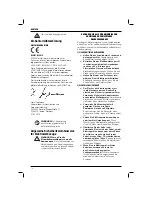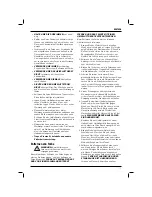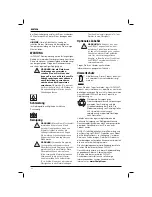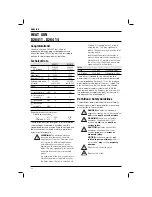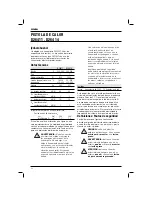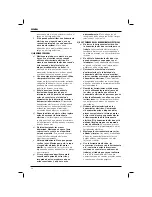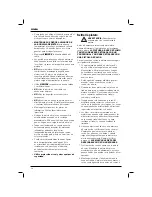
ENGLISH
27
•
DO NOT
poke anything down the nozzle as
it could give you an electric shock. Do not
look down the nozzle while the unit is working
because of the high temperatures being
produced.
•
DO NOT
allow paint to adhere to the nozzle or
scraper as it could ignite after some time.
•
DO NOT
remove the heat barrel cover during
use.
Additional Safety Warnings for Heat
Guns
• To reduce the risk of explosion,
DO NOT
use
in paint spray booths or within 3.0 m of paint
spraying operations.
•
DO NOT use this tool to remove paint
containing lead.
The peelings, residue and
vapors of paint may contain lead which is
poisonous
• Hidden areas such as behind walls, ceilings,
floors, soffit boards and other panels may
contain flammable materials that could be
ignited by the heat gun when working in these
locations. The ignition of these materials may
not be readily apparent and could result in
property damage and injury to persons. When
working in these locations, keep the heat gun
moving in a back-and-forth motion. Lingering or
pausing in one spot could ignite the panel or the
material behind it.
NOTE:
These heat guns are capable of
producing temperatures in excess of 550° C.
•
DO NOT
use this tool to heat food.
•
DO NOT
lay the heat gun on flammable
surfaces when operating the gun or immediately
after shutting it off.
• Keep moveable items secured and steady while
scraping.
• Be sure to direct the hot air blast in a safe
direction; away from other people or flammable
objects.
•
KEEP FINGERS AWAY FROM METAL
NOZZLE;
it becomes very hot during use and
remains hot for 30 minutes after use
.
Wear
gloves to protect hands.
•
ALWAYS
keep nozzle away from cord.
• Splinters and small particles of stripped paint
can be ignited and blown through holes and
cracks in the surface being stripped.
•
DO NOT
burn the paint. Use the scraper
provided and keep the nozzle at least 25 mm
away from the painted surface. When working in
a vertical direction, work downwards to prevent
paint from falling into the tool and burning.
•
ALWAYS
use good quality scrapers and
stripping knives.
•
DO NOT
use the heat gun in combination with
chemical strippers.
•
DO NOT
use accessory nozzles as scrapers.
•
DO NOT
direct heatgun airflow directly on
glass. The glass may crack and could result in
property damage or personal injury.
• Maintain labels and nameplates. These carry
important information.
• Place the heat gun on a stable, level surface
when not hand held. Place the cord in a
position that won't cause the heat gun to tip
over.
• Be constantly aware that this tool can ignite
flammable materials, soften or melt others.
Regardless of the task you are performing,
shield or keep the heat gun away from these
materials.
• You may occasionally notice some slight
smoking of the tool after it is turned off. This is
the result of heating the residual oil that was
deposited on the heating element during the
manufacturing process.
•
Use eye protection and other safety
equipment.
Removing Paint
WARNING:
Extreme care should be
taken when stripping paint.
Before beginning any paint removal process
you should determine whether the paint you
are removing contains lead.
LEAD-BASED
PAINT SHOULD ONLY BE REMOVED BY
A PROFESSIONAL AND SHOULD NOT BE
REMOVED USING A HEAT GUN.
Persons removing paint should follow these
guidelines:
1. Move the workpiece outdoors. If this is not
possible, keep the work area well ventilated.
Open the windows and put an exhaust fan in
one of them. Be sure the fan is moving the air
from inside to outside.
2. Remove or cover any carpets, rugs, furniture,
clothing, cooking utensils and air ducts.
3. Place drop cloths in the work area to catch any
paint chips or peelings. Wear protective clothing
such as extra work shirts, overalls and hats.
Summary of Contents for D26411
Page 1: ...www eu D26411 D26414 ...
Page 3: ...1 Figure 1 a c b d e f g D26411 a c b d e f g D26414 h d ...
Page 4: ...2 Figure 2 Figure 3 Figure 4 A ...
Page 145: ...143 ...
Page 146: ...144 ...
Page 147: ...145 ...


